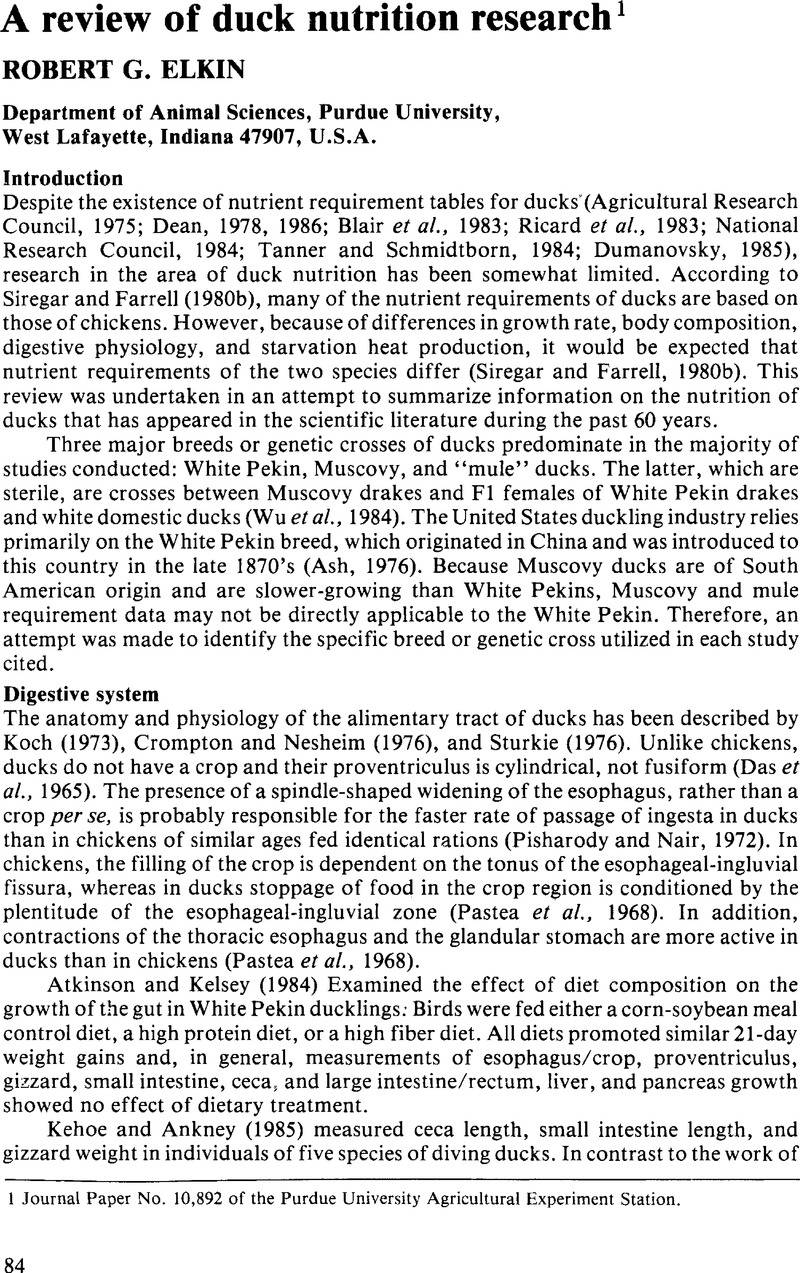Crossref Citations
This article has been cited by the following publications. This list is generated based on data provided by Crossref.
FARRELL, D.J.
1990.
Recent Advances in Animal Nutrition.
p.
177.
Auvergne, A.
Baudonnet, Catherine
and
Babile, R.
1991.
Influence of protein and methionine concentrations and body size on the growth and carcase of muscovy ducks in the finishing stage of production.
British Poultry Science,
Vol. 32,
Issue. 2,
p.
353.
Jones, J. M.
and
Grey, T. C.
1995.
Processing of Poultry.
p.
127.
Ragland, D
King, D
and
Adeola, O
1997.
Determination of metabolizable energy contents of feed ingredients for ducks.
Poultry Science,
Vol. 76,
Issue. 9,
p.
1287.
Ragland, D
Thomas, CR
Elkin, RG
Shafer, DJ
and
Adeola, O
1999.
The influence of cecectomy on metabolizable energy and amino acid digestibility of select feedstuffs for white Pekin ducks.
Poultry Science,
Vol. 78,
Issue. 5,
p.
707.
Xu, Ning-Ying
Wu, Yao-Ming
Chen, Xue-Jun
and
Liu, Jian-Xin
2002.
Investigation on requirement of crude protein for maintenance in Shaoxing ducks.
Animal Feed Science and Technology,
Vol. 98,
Issue. 3-4,
p.
167.
He, J.H.
Li, J.B.
Gao, F.X.
Liu, Q.H.
Shu, J.C.
and
Liu, D.J.
2003.
Dietary methionine requirement of the Chinese egg-laying duck.
British Poultry Science,
Vol. 44,
Issue. 5,
p.
741.
Timmler, R
and
Rodehutscord, M
2003.
Dose-response relationships for valine in the growing White Pekin duck.
Poultry Science,
Vol. 82,
Issue. 11,
p.
1755.
Zhang, C.L.
Hou, S.S.
Wang, Y.H.
Liu, F.Z.
and
Xie, M.
2007.
Feed input and excreta collection time in metabolisable energy assays for ducks.
Czech Journal of Animal Science,
Vol. 52,
Issue. 12,
p.
463.
Hoai, H.T.
Kinh, L.V.
Viet, T.Q.
Sy, P.V.
Hop, N.V.
Oanh, D.K.
and
Yen, N.T.
2011.
Determination of the metabolizable energy content of common feedstuffs in meat-type growing ducks.
Animal Feed Science and Technology,
Vol. 170,
Issue. 1-2,
p.
126.
Choo, Y. K.
Kwon, H. J.
Oh, S. T.
Kang, C. W.
Kim, H. K.
Hong, E. C.
Heo, K. N.
Lee, S. K.
and
An, B. K.
2014.
Growth Performance and Carcass Characteristics of Korean Native Ducks Fed Diets with Varying Levels of Limiting Amino Acids.
Asian-Australasian Journal of Animal Sciences,
Vol. 27,
Issue. 4,
p.
518.
Baéza, E.
2016.
Nutritional requirements and feed management of meat type ducks.
World's Poultry Science Journal,
Vol. 72,
Issue. 1,
p.
5.
Li, Lan
Zhang, Xiaoyi
Zhao, Lihong
Zhang, Jianyun
Ji, Cheng
and
Ma, Qiugang
2021.
Phosphorus Restriction in Brooding Stage Has Continuous Effects on Growth Performance and Early Laying Performance of Layers.
Animals,
Vol. 11,
Issue. 12,
p.
3546.
Li, Lan
Zhang, Xiaoyi
Zhang, Jiatu
Liu, Meiling
Zhao, Lihong
Ji, Cheng
Zhang, Jianyun
Huang, Shimeng
and
Ma, Qiugang
2022.
Growth Performance, Bone Development and Phosphorus Metabolism in Chicks Fed Diets Supplemented with Phytase Are Associated with Alterations in Gut Microbiota.
Animals,
Vol. 12,
Issue. 7,
p.
940.
Wang, Heng
Wang, Xuyang
Zhan, Yuchun
Peng, Bin
Wang, Wence
Yang, Lin
and
Zhu, Yongwen
2023.
Predicting the metabolizable energy and metabolizability of gross energy of conventional feedstuffs for Muscovy duck using in vitro digestion method.
Journal of Animal Science,
Vol. 101,
Issue. ,





